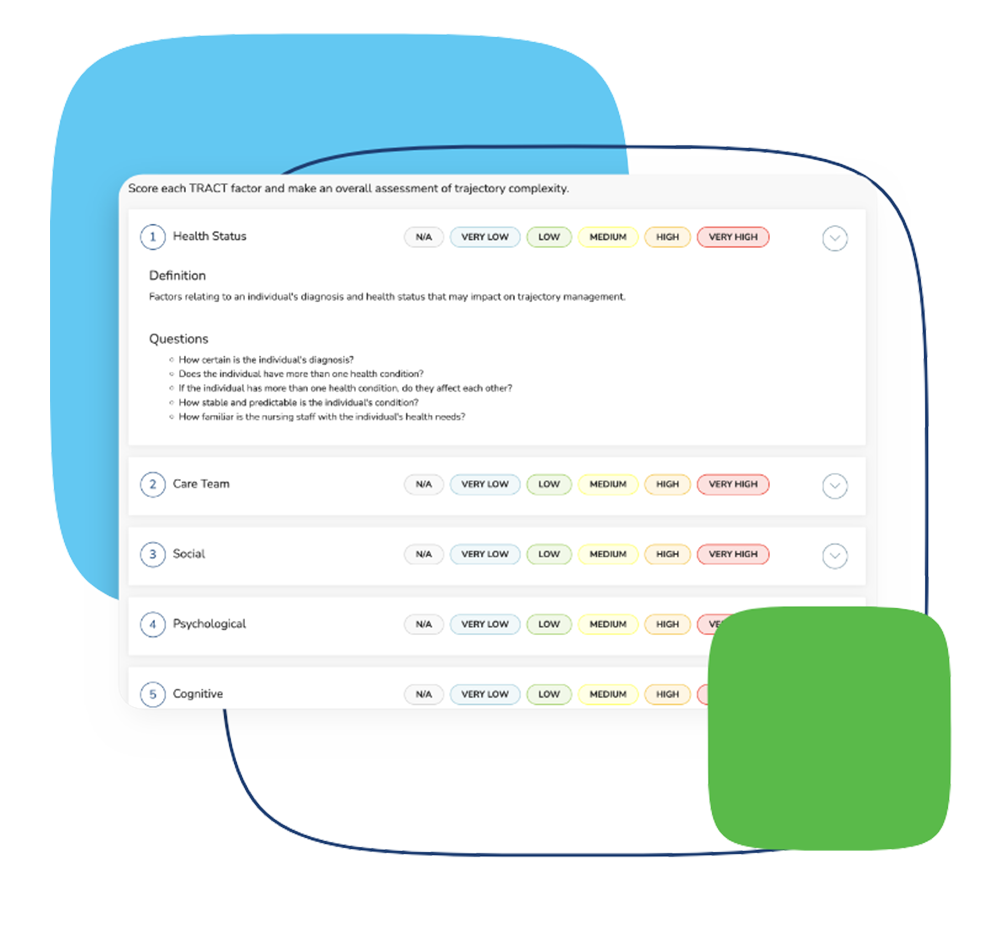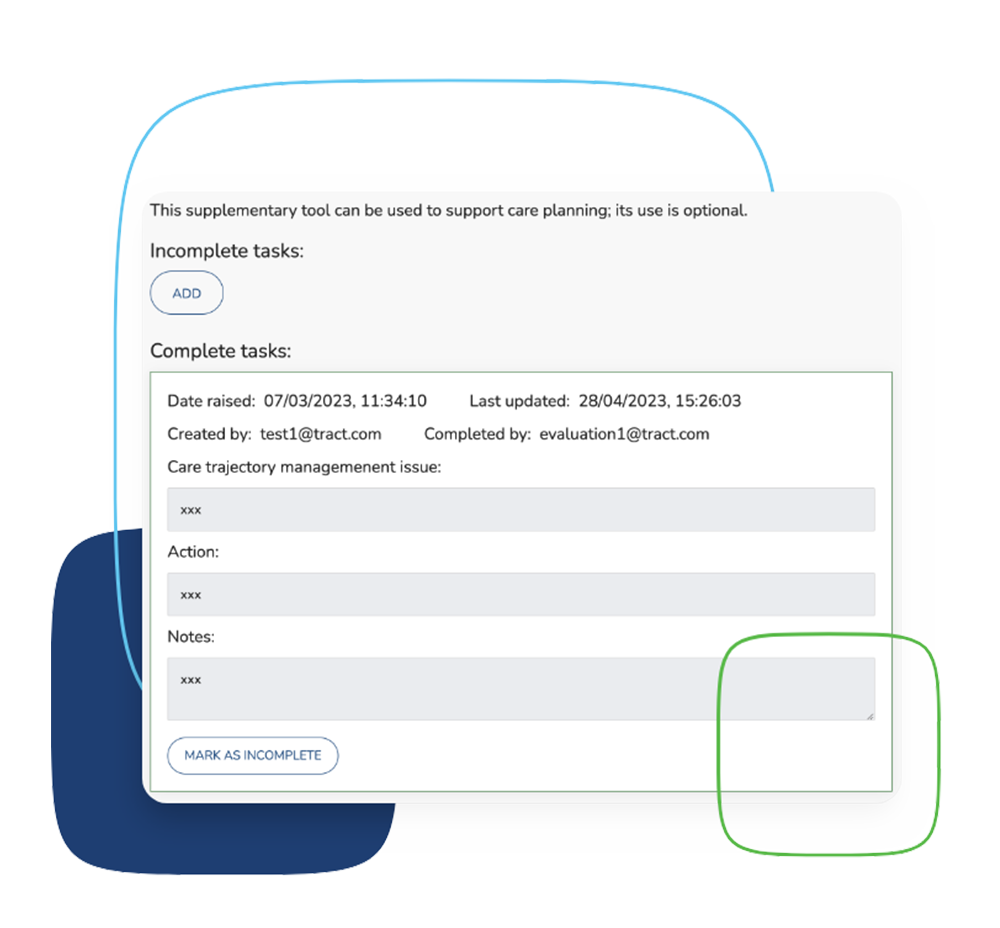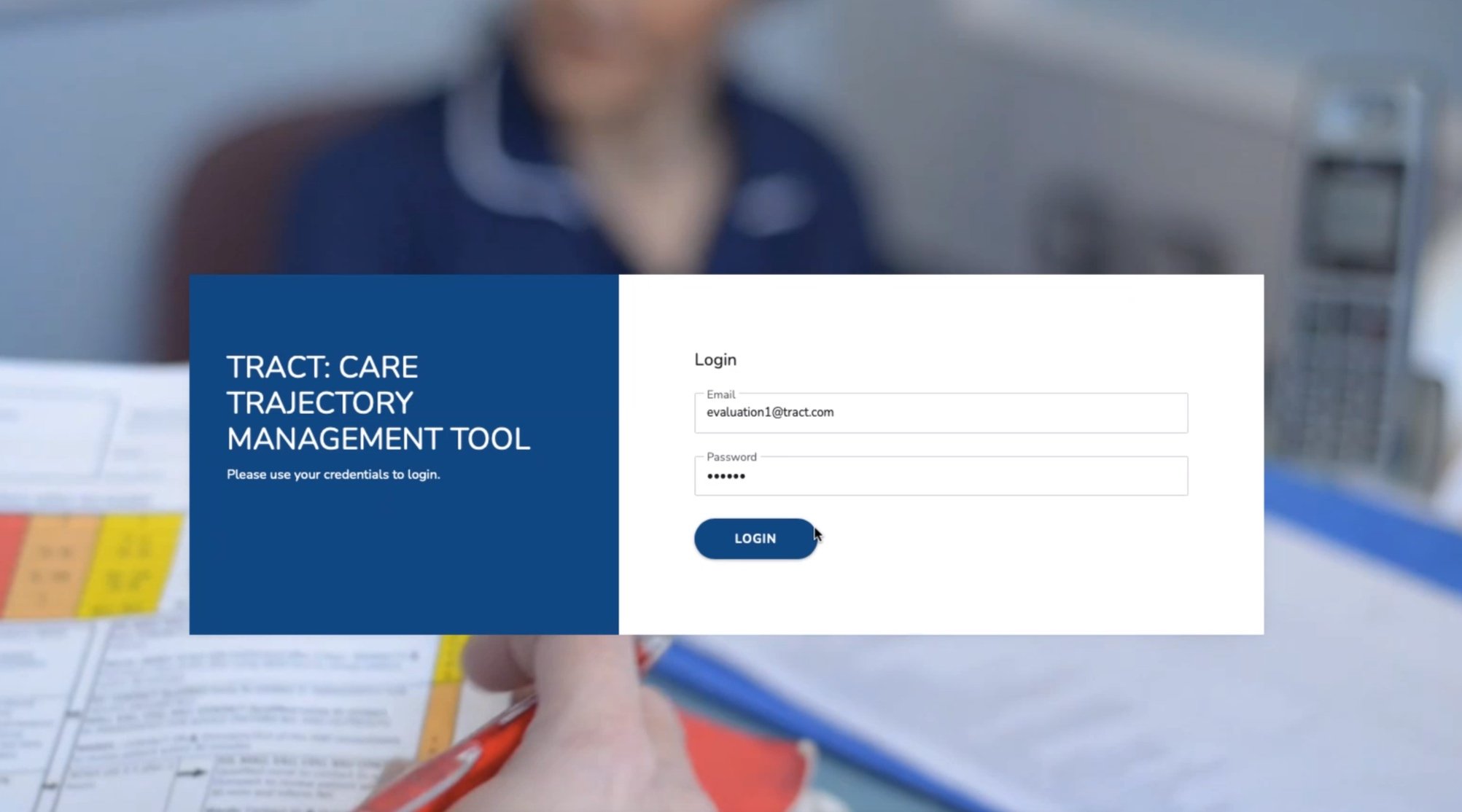TRACT features
Transform your healthcare experience with TRACT, the innovative app designed to support patient care organisation. Improve efficiency, make data-driven decisions, and integrate patient care with ease.
Watch our video demo
Discover how simple the process is.
Easy to use
Simple interface with multi-device functionality.
Visualise
Instantly visualise the workload across any clinical setting.
Integrate
Seamlessly integrate TRACT into your everyday workload.
Key features
-

Easy to use
TRACT’s user-friendly design places all the information you need at your fingertips.
-

Clear data visualisation
TRACT data is displayed as easy-to-read heat maps.
-

Use across a range of digital platforms
TRACT can be used on any web-enabled device (computer, tablet, smart phone).
-

Simple assessment framework
The organisational complexity of patient care is assessed using a simple patient assessment framework.
-

TRACT data
TRACT generates data on:
1) individual patients
2) patient caseloads
3) unit care trajectory management work
4) divisional aggregate data
-

Export and share
TRACT heat-maps can be downloaded as an image file, ready for online sharing, electronic or printed display, or use in key documents. Information recorded within the TRACT planner can be exported for annotation or use alongside other nursing tools or frameworks.
-

Real-time information
TRACT uses patient assessments to generate real-time information.
-

API
The TRACT Application Processing Interface allows data sharing with other nurse staffing technologies and systems. Used alongside other forms of nurses staffing data, TRACT can be used to inform nurse staffing decisions.
-

Can be adapted to local context
TRACT can be adapted to align with the specific needs of the clinical environment. The TRACT Implementation Guide includes materials to enable tailoring for local use.

“It’s not just the vibe of the ward anymore.”
TRACT user | Australia
Assess, measure, plan & manage
-

Assess
Using the five point scale, assess the patient against the 10 TRACT Factors known to impact on the organisational complexity of patient care. Prompts are provided for each factor to support this process.
-

Measure
Review the patient TRACT Factor scores and arrive at an overall trajectory complexity score.
-

Plan
The integrated TRACT Planner enables planning to follow assessment, and progress on planning to be reflected in subsequent patient assessments.
-

Manage
TRACT generates data on the types of care trajectory work associated with the patient population. This is useful for nurse managers in identifying features of the clinical environment that could be adding to the organisational aspects of the nursing workload. Have admissions and referral processes changed? Are there issues with team working? Is there an educational need?
Watch our video demo
Discover how simple the process is.
Easy to use
Simple interface with multi-device functionality.
Visualise
Instantly visualise the workload across any clinical setting.
Integrate
Seamlessly integrate TRACT into your everyday workload.
FAQs
-
There is a growing recognition of the value of a triangulated approach in assessing nursing workload. This involves using multiple tools to generate information on different aspects of the nursing workload to inform nurse staffing decisions.
Tools exist for measuring patient acuity or dependency. TRACT can be used to generate information on the organisational elements of patient care which can be considered alongside other data.
-
There are no hard and fast rules as to how often TRACT should be used. The frequency of use depends on your purposes. It could be used to capture a snapshot of nursing work at a point in time. Examples of this pattern of use include:
periodic reviews of the nursing workload to inform establishment setting.
for diagnostic purposes if there are concerns about the clinical environment.
TRACT can also be used daily to generate real time data on nursing workload for the purposes of managing staffing in response to fluctuations in demand.
-
The Implementation Guide provides step by step instructions on how to calibrate assessments to ensure TRACT is used consistently.
-
TRACT is designed to be adapted to the clinical context. The Implementation Guide provides guidance on tailoring TRACT for local use.
-
TRACT displays data on 10 TRACT Factors that impact the organisational complexity of patient care. When TRACT assessments are undertaken for all patients on a unit or ward, the volume and complexity of the work associated with each TRACT factor can be displayed.
This means that TRACT can offer a ward manager evidence of those aspects of the workload that might be addressed to reduce the burdens of organisational work on staff or better understand, how a short-term issue may be impacting the work of nurses.
-
TRACT takes the patient as the unit of assessment. The data generated by the tool can be complemented by other indicators which help to build up an understanding of the organisational complexity of nursing work.
For example, we know that in the hospital context the volume of outliers, admissions and discharges, and agency staff use all impact on the organisational workload of nurses. There may be other factors for which routine data is available in your clinical setting.
-
Care trajectory management is a complex nursing skill which involves organisational and clinical knowledge. In the past, student nurses received limited explicit preparation for this aspect of their work, with expertise in care trajectory management typically built up after qualification.
TRACT provides a structure and rationale for supporting students in assessing and planning the organisational aspects of patient care. It can be used on clinical placement or applied to patient case studies in the academic setting. There are links to additional resources on the CTM website which signpost the theories and concepts of care trajectory management, which may also be of value.
-
TRACT can be used flexibly for research purposes. It can be used as a quantitative measurement tool, as a framework for guiding observational research, or as a framework for analysis of interview data.
The principles which guide the use of TRACT for research purposes are no different from those which apply to the use of any other tools and frameworks. Transparency is key. In studies which involve more than one researcher, the TRACT calibration guidance in the Implementation Guide may be of value to ensure the consistency of TRACT use.
If a higher level of specificity is required in the application of the TRACT Factors, then the TRACT tailoring template in the Implementation Guide allows TRACT to be adapted to specify areas of interest for the study.
-
TRACT can identify where the organisational elements of patient care are complex, even if the person is not highly dependent or has acute care needs. For example, patients newly admitted for elective surgery may require high levels of organisational work, but have low acute or dependency needs - or patients who are fit to leave hospital may have low acuity and dependency needs, but require high volume of nursing work to organise discharge.
In these examples, skill mix decisions based on acuity and dependency scores alone, may have missed the requirement for registered nursing organising work.
Equally, the organisational elements of patient care often depend on organisational knowledge as well as clinical knowledge. Using agency staff, without familiarity with the organisational context to ensure nurse staffing levels are safe, would have a limited impact on the actual workload of nursing staff.
-
TRACT Factors are deliberately broad so that they can be applied to a wide range of contexts. Please see the Implementation Guide for advice on local tailoring.
“We wanted to create a tool that was genuinely useful for nurses.”
Prof. Davina Allen Cardiff University



